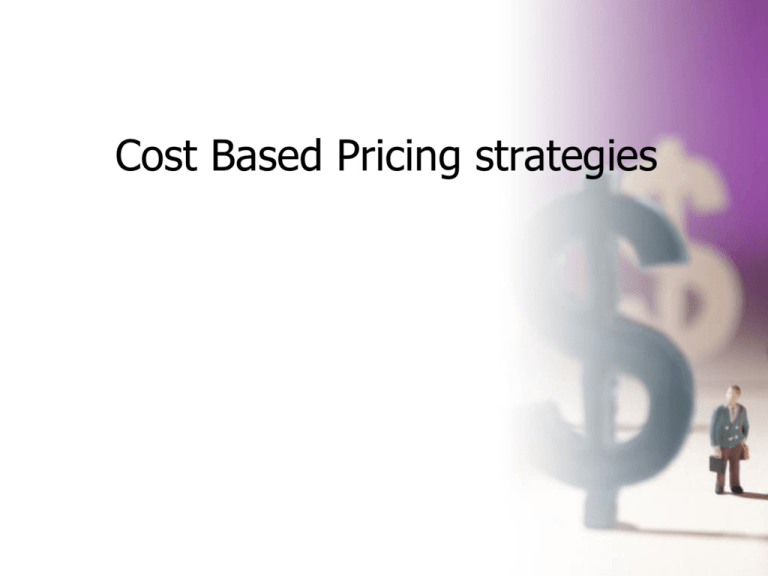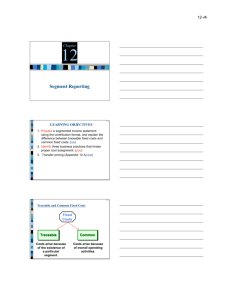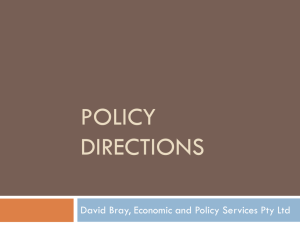Cost - Surej P John
advertisement

Cost Based Pricing strategies Importance of Costs in pricing • Costs information indicates whether the product can be made and sold profitably in any price. • Apart from the production costs, costs for selling, marketing, distribution and general administrative costs are very adequate to determine the profitability of a project. • The most commonly used method to set prices is the “cost plus” and “mark up pricing” strategies. • Cost for pricing must deal with the future. Cost Classifications • It is important to clarify what is meant by direct and indirect: – Directly traceable or attributable costs: Cost that can be readily determined as contributing to the product or service’s cost. – Indirect traceable costs Cost that can be objectively traced to a segment or product categories. Cost Classifications • Common costs support a number of activities or profit segments and cannot be objectively traced to a product or segment based on a direct physical relationship to that product or segment • Opportunity costs reflect the “cost” of not choosing the best alternative or opportunity Cost Classifications • Cash costs can lead to cash (or out-ofpocket) outlays or bookkeeping (depreciation or amortization) entries • Noncash costs do impact the cash flows but do not reflect actual monetary outlays in a particular accounting period Cost Classifications • How do costs vary with changes in activity rate? • DIRECT VARIABLE COSTS: – Vary directly with activity level; – the major criterion of a direct variable cost is that it be traceably and tangibly generated by, and identified with a particular activity. – E.g., raw materials, sales expenses, utilities. Cost Classifications • How do costs vary with changes in activity rate? • SEMIVARIABLE COSTS: – Costs that vary with activity rates, but are not zero at a zero activity rate. These costs consist of a base amount that is constant in relation to activity and a variable amount that varies directly with activity. – E. g., data processing, supplies, maintenance. Cost Classifications • How do costs vary with changes in activity rate? • PERIOD FIXED COSTS: – These costs do not vary with activity. They remain fixed over a period of time due to previous decisions. Some fixed costs may be traceable to specific activities by reasonable objective means. Other fixed costs are general and not easily traceable to an activity. Breakeven Concept One Unit 10,000 units $20 $200,000 Variable costs Fixed costs 16 160,000 2 20,000 Total costs 18 180,000 2 20,000 Sales Profits Breakeven Formulas • Breakeven quantity: BEQ FC [ P VC] • • • • where BEQ = break-even sales quantity FC = fixed costs P = selling price VC = variable costs BEQ $20,000 [$20 16] BEQ 5,000 Breakeven Formulas • Breakeven sales revenue BES FC PV • where BES = break-even sales revenue • FC = fixed costs • PV = Profit-Volume Ratio: PV [ P VC] P PV [$20 16] $20 0.20 BES $20,000 0.20 $100,000 Break-Even Analysis A change in fixed costs affects only the breakeven point A change in the price and/or variable costs affects both the break-even point and the PV An increase in prices and/or decrease in variable costs can offset an increase in fixed expenses (assuming volume remains unaffected) Limitations of Break-Even Analysis The assumption that variable costs remain proportional to volume at all output levels The assumption that price is constant over relevant volume levels Costs used the in the analysis may be relevant over a limited range of volume Cost-Plus Pricing (Mark up pricing) 1. Cover costs Material Labor Capital resources Marketing variable costs fixed costs 2. Mark-up Targeted return for shareholders Costs + mark-up = Sales price $1.00 + $0.50 = $1.50 (50% markup) Mark up price MUP = UC/(1- ROS) MUP = Mark up price UC = Unit Cost ROS = Expected return on sales UC= VC + FC/ Unit sales(not dollars) • Cost based pricing method does not take into consideration supply/demand, or even market status. • It is purely based on the cost of the production of the product dollars per unit of final product (raw materials, manual labour, etc..). Target return pricing TRP = UC + ( R x I)/ US TRP = Target return price UC = Unit cost R = Expected return on investment I = Invested capital US = Unit sales expected Pricing method whereby the selling price of a product is calculated to produce a particular rate of return on investment for a specific volume of production. The target pricing method is used most often by public utilities, like electric and gas companies, and companies whose capital investment is high, like automobile manufacturers.





